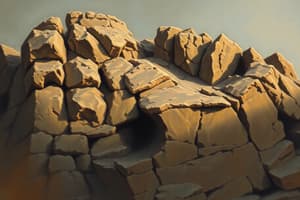Podcast
Questions and Answers
How are sedimentary rocks formed?
How are sedimentary rocks formed?
Sedimentary rocks are formed by the compaction and cementation of sediment or by the chemical precipitation of minerals.
What are clastic sedimentary rocks?
What are clastic sedimentary rocks?
Clastic sedimentary rocks are produced by the compaction and cementation of rock and mineral fragments derived from weathering or preexisting rock.
What are the size classes used to describe clastic rocks?
What are the size classes used to describe clastic rocks?
The size classes are clay and silt (mud size), fine and coarse (sand size), and pebbles, cobbles, and boulders (gravel size).
What are the three types of sedimentary rocks?
What are the three types of sedimentary rocks?
Describe the typical composition of each clast size.
Describe the typical composition of each clast size.
What is fissility?
What is fissility?
What are chemically precipitated rocks?
What are chemically precipitated rocks?
What are the three textures of chemical rocks?
What are the three textures of chemical rocks?
Describe crystalline texture.
Describe crystalline texture.
Describe dense texture.
Describe dense texture.
Describe oolitic texture.
Describe oolitic texture.
How are chemical rocks classified?
How are chemical rocks classified?
Describe the two carbon-rich sedimentary rocks.
Describe the two carbon-rich sedimentary rocks.
Flashcards are hidden until you start studying
Study Notes
Formation of Sedimentary Rocks
- Formed by compaction and cementation of sediments or chemical precipitation of minerals.
- Typically form at or near the Earth's surface.
Clastic Sedimentary Rocks
- Result from compaction and cementation of rock and mineral fragments called clasts, derived from weathering.
- Classified by clast size.
Clast Size Classification
- Smallest to largest sizes:
- Clay and silt (mud size)
- Fine and coarse (sand size)
- Pebbles, cobbles, and boulders (gravel size)
Types of Sedimentary Rocks
- Three primary types:
- Clastic
- Chemically precipitated
- Carbon-rich (organic)
Composition of Clast Sizes
- Gravel-sized clasts mainly consist of rock fragments.
- Sand-sized clasts primarily consist of minerals like quartz.
- Mud-sized clasts are predominantly clay minerals.
Fissility
- Characteristic of rocks with mud-size clasts, capable of breaking into thin layers.
- arises from alignment of sheet-like clay minerals, creating planes of weakness.
- Common in shale, which is typically fissile.
Chemically Precipitated Rocks
- Form in aqueous environments through inorganic processes or biological actions.
- Examples include:
- Carbonate rocks (calcite)
- Siliceous rocks (quartz)
- Evaporite rocks (gypsum and halite)
Textures of Chemical Rocks
- Three main textures:
- Crystalline
- Dense
- Oolitic
Crystalline Texture
- Features minerals visible to the naked eye, including fossil fragments.
Dense Texture
- Characterized as fine-grained, with crystals not visible to the naked eye.
Oolitic Texture
- Contains sand-sized, spherical particles that grow in layers, akin to pearl formation in mollusks.
Classification of Chemical Rocks
- Primarily classified by rock composition.
- Common minerals include:
- Calcite (limestone)
- Quartz (chert)
- Gypsum and halite (evaporites)
Carbon-rich Sedimentary Rocks
- Two types:
- Peat: Composed of compressed plant fibers; soft and easily breaks apart.
- Coal: Dark brown to black with a dull to shiny luster; may be brittle.
Studying That Suits You
Use AI to generate personalized quizzes and flashcards to suit your learning preferences.




